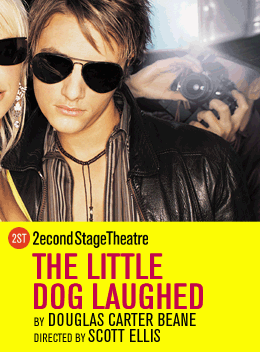The Urban Etiquette Handbook Part 6
What the Waiter Wants
How to give orders the nice way.
Only four Manhattan restaurants still require jackets—but good manners are de rigueur everywhere. During a noon round table at Pravda, our six food-and-drink-service vets drew up a list of dos and don’ts for restaurant dining.
Kathleen Flanagan, waitress, the Mermaid Inn; 12 years’ experience
Troy Daigle, beverage director, Le Bernardin; 20 years
“Chops,” bartender and owner, King’s County Bar; 10 years
Jim Hutchinson, wine director, Centovini; 23 years
Adrian Murcia, waiter, Chanterelle; 18 years
Daryl Dismond, maître d’, Pravda; 18 years
Is there a best way to order?
Dismond: Acknowledge the server and look at him. You don’t have to make eye contact the whole time, but it’s very offensive to give your order and never even look up. Flanagan: I am a big fan of “May I?” “I’d like to . . . ” “Could you please?” I don’t need to be bowed down to, but I don’t like “I’m gonna take the . . . ,” “Could you get me the . . . ” Murcia: I don’t need “please” and “thank you”; just don’t be rude.
Is it okay to send back a bottle of wine?
Flanagan: When you order a wine you are not that familiar with, you’re taking a risk. If you don’t love it, you don’t get to send it back. But if I suggest something and you don’t like it, then that’s my fault. Daigle: Because we have over 800 labels on our list, we have to guide people and allow them to try something different. If they’re not ecstatic about it, I’m taking it away and bringing something else.
What about food?
Daigle: Do it politely, but let them know how it’s different from what you expected. Flanagan: It’s not that big a deal to send something back. It’s not offensive. Dismond: Remember your server didn’t cook it.
How can I signal that I don’t want to be hurried through my meal?
Murcia: Put a fork on the left-hand side of your plate and the knife on the right, leaving them half on the plate, half on the table. To show that you are done, put the fork along with the knife parallel, bottom right to top left. When you want your wine glass cleared, put it in the center of the table.
Is it ever appropriate to tip less than 20 percent?
Flanagan: Not unless something goes terribly wrong. Daigle: A bad tip is counterproductive for everyone. There’s no excuse. Chops: Say yes to 20 percent tipping. We remember good tippers. Dismond: Fifteen percent is not a shabby tip. Anything less—especially under 10 percent—should happen only if your server continues mixing up orders, bringing out the wrong food, and is generally rude and inattentive. But if the food comes out prepared incorrectly, that’s the chef’s fault.
How should I calculate the tip when an expensive bottle of wine or caviar radically pumps up the price without requiring extra service?
Hutchinson: If you spend that much money, the restaurant probably merits that gratuity. If you’re just eating a sandwich and opt for the $200 bottle of wine, then you might not leave the full 20 percent. Tips depend on context.
How do you tip when you are treated to something on the house?
Murcia: Add the amount of the free food or drink as if you paid for it, and calculate the tip based on that. If you get a full comp, tip based on the full amount. Chops: What I do is send a cocktail to the whole kitchen.
Is there anything else one can do to express appreciation?
Murcia: Send a card. It’s such a nice gesture: Letters are read aloud at staff meetings—the good ones and bad—and nothing feels better. Flanagan: Next time you’ll be recognized and treated even better.
VIA NEW YORK MAGAZINE
How to give orders the nice way.
Only four Manhattan restaurants still require jackets—but good manners are de rigueur everywhere. During a noon round table at Pravda, our six food-and-drink-service vets drew up a list of dos and don’ts for restaurant dining.
Kathleen Flanagan, waitress, the Mermaid Inn; 12 years’ experience
Troy Daigle, beverage director, Le Bernardin; 20 years
“Chops,” bartender and owner, King’s County Bar; 10 years
Jim Hutchinson, wine director, Centovini; 23 years
Adrian Murcia, waiter, Chanterelle; 18 years
Daryl Dismond, maître d’, Pravda; 18 years
Is there a best way to order?
Dismond: Acknowledge the server and look at him. You don’t have to make eye contact the whole time, but it’s very offensive to give your order and never even look up. Flanagan: I am a big fan of “May I?” “I’d like to . . . ” “Could you please?” I don’t need to be bowed down to, but I don’t like “I’m gonna take the . . . ,” “Could you get me the . . . ” Murcia: I don’t need “please” and “thank you”; just don’t be rude.
Is it okay to send back a bottle of wine?
Flanagan: When you order a wine you are not that familiar with, you’re taking a risk. If you don’t love it, you don’t get to send it back. But if I suggest something and you don’t like it, then that’s my fault. Daigle: Because we have over 800 labels on our list, we have to guide people and allow them to try something different. If they’re not ecstatic about it, I’m taking it away and bringing something else.
What about food?
Daigle: Do it politely, but let them know how it’s different from what you expected. Flanagan: It’s not that big a deal to send something back. It’s not offensive. Dismond: Remember your server didn’t cook it.
How can I signal that I don’t want to be hurried through my meal?
Murcia: Put a fork on the left-hand side of your plate and the knife on the right, leaving them half on the plate, half on the table. To show that you are done, put the fork along with the knife parallel, bottom right to top left. When you want your wine glass cleared, put it in the center of the table.
Is it ever appropriate to tip less than 20 percent?
Flanagan: Not unless something goes terribly wrong. Daigle: A bad tip is counterproductive for everyone. There’s no excuse. Chops: Say yes to 20 percent tipping. We remember good tippers. Dismond: Fifteen percent is not a shabby tip. Anything less—especially under 10 percent—should happen only if your server continues mixing up orders, bringing out the wrong food, and is generally rude and inattentive. But if the food comes out prepared incorrectly, that’s the chef’s fault.
How should I calculate the tip when an expensive bottle of wine or caviar radically pumps up the price without requiring extra service?
Hutchinson: If you spend that much money, the restaurant probably merits that gratuity. If you’re just eating a sandwich and opt for the $200 bottle of wine, then you might not leave the full 20 percent. Tips depend on context.
How do you tip when you are treated to something on the house?
Murcia: Add the amount of the free food or drink as if you paid for it, and calculate the tip based on that. If you get a full comp, tip based on the full amount. Chops: What I do is send a cocktail to the whole kitchen.
Is there anything else one can do to express appreciation?
Murcia: Send a card. It’s such a nice gesture: Letters are read aloud at staff meetings—the good ones and bad—and nothing feels better. Flanagan: Next time you’ll be recognized and treated even better.
VIA NEW YORK MAGAZINE










0 Comments:
Post a Comment
<< Home